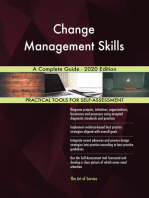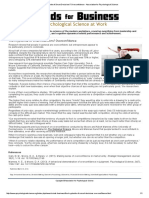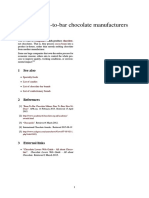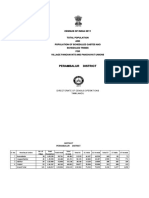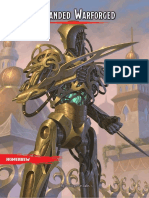Change Management: 1 History
Change Management: 1 History
Uploaded by
alberto micheliniCopyright:
Available Formats
Change Management: 1 History
Change Management: 1 History
Uploaded by
alberto micheliniOriginal Description:
Original Title
Copyright
Available Formats
Share this document
Did you find this document useful?
Is this content inappropriate?
Copyright:
Available Formats
Change Management: 1 History
Change Management: 1 History
Uploaded by
alberto micheliniCopyright:
Available Formats
Change management
For software version changes, see Change control.
Robert Marshak has since credited the big 6 accounting and consulting rms with adopting the work of early
organizational change pioneers, such as Daryl Conner
Change Management (CM) refers to any approach to
transitioning individuals, teams, and organizations using and Don Harrison, thereby contributing to the legitimization of a whole change management industry when they
methods intended to re-direct the use of resources, busiservices as change manageness process, budget allocations, or other modes of op- branded their reengineering
ment in the 1980s.[7]
eration that signicantly reshape a company or organization. Organizational Change Management (OCM) considers the full organization and what needs to change.[1]
Organizational Change Management principles and prac- 1.3 1990s
tices include CM as a tool for change focused solely on
the individual.
In his 1993 book, Managing at the Speed of Change, Daryl
CM focuses on how people and teams are aected by Conner coined the term 'burning platform' based on the
an organizational transition. It deals with many dif- 1988 North Sea Piper Alpha oil rig re. He went on to
ferent disciplines, from behavioral and social sciences found Conner Partners in 1994, focusing on the human
to information technology and business solutions. In a performance and adoption techniques that would help enproject management context, CM may refer to the change sure technology innovations were absorbed and adopted
[8]
control process wherein changes to the scope of a project as best as possible.
are formally introduced and approved.[2][3]
1
1.1
1.4 2000s
History
Linda Ackerman Anderson states in Beyond Change
Management that in the late 1980s and early 1990s, top
leaders, growing dissatised with the failures of creating
and implementing changes in a top-down fashion, created
the role of the change leader to take responsibility for the
human side of the change.[9] The rst State of the Change
Management Industry report was published in the Consultants News in February 1995.[10]
1960s
Many change management models and processes are
based with their roots in grief studies. As consultants saw
a correlation between grieving from health-related issues
and grieving among employees in an organization due to
loss of jobs and departments, many early change models
captured the full range of human emotions as employees
mourned job-related transitions.[4]
1.5 2010s
In his work on Diusion of Innovations, Everett Rogers
posited that change must be understood in the context of
time, communication channels, and its impact on all affected participants. Placing people at the core of change
thinking was a fundamental contribution to developing
the concept of change management. He proposed the
descriptive Adopter groups of how people respond to
change: Innovators, Early Adopters, Early Majority, Late
Majority and Laggards.[5]
1.2
In Australia, change management is now recognised as
a formal vocation through the work of Christina Dean
with the Australian government in establishing national
competency standards and academic programmes from
diploma to masters level.[11]
In response to continuing reports of the failure of largescale top-down plan-driven change programmes,[12] innovative change practitioners have been reporting success
with applying Lean and Agile principles to the eld of
change management.[13][14]
1980s
McKinsey & Company consultant Julien Phillips published a change management model in 1982 in the journal
Human Resource Management, though it took a decade
for his change management peers to catch up with him.[6]
The Association of Change Management Professionals
(ACMP) announced a new certication to enhance the
profession: Certied Change Management Professional,
planned for 2016.[15]
1
APPROACH
Approach
Organizational change management employs a structured approach to ensure that changes are implemented
smoothly and successfully to achieve lasting benets.
2.1
Reasons for change
Globalization and constant innovation of technology result in a constantly evolving business environment. Phenomena such as social media and mobile adaptability have
revolutionized business and the eect of this is an ever
increasing need for change, and therefore change management. The growth in technology also has a secondary
eect of increasing the availability and therefore accountability of knowledge. Easily accessible information has
resulted in unprecedented scrutiny from stockholders and
the media and pressure on management.
With the business environment experiencing so much
change, organizations must then learn to become com- Dr. John P. Kotter, a pioneer of change management, invented
fortable with change as well. Therefore, the ability to the 8-Step Process for Leading Change
manage and adapt to organizational change is an essential ability required in the workplace today. Yet, ma Communicate the Change Vision
jor and rapid organizational change is profoundly dicult because the structure, culture, and routines of orga Empower Employees for Broad-Based Action
nizations often reect a persistent and dicult-to-remove
imprint of past periods, which are resistant to radical
Generate Short-Term Wins
change even as the current environment of the organiza Consolidate Gains and Produce More Change
tion changes rapidly.[16]
Due to the growth of technology, modern organizational
change is largely motivated by exterior innovations rather
than internal factors. When these developments occur,
the organizations that adapt quickest create a competitive advantage for themselves, while the companies that
refuse to change get left behind.[17] This can result in drastic prot and/or market share losses.
Anchor New Approaches in the Culture
Change Management Foundation and Model
The Change Management Foundation is shaped like a
pyramid with project management managing technical
aspects and people implementing change at the base and
Organizational change directly aects all departments and leadership setting the direction at the top. The Change
employees. The entire company must learn how to handle Management Model consists of four stages:
changes to the organization.
Determine Need for Change
2.2
Change Models
Among the many methods of change management exist
several key models:
Prepare & Plan for Change
Implement the Change
Sustain the Change
John Kotters 8-Step Process for Leading Change
Deming Cycle of Plan-Do-Check-Act
Dr. John P. Kotter, the Konosuke Matsushita Professor
of Leadership, Emeritus, at the Harvard Business School, The Plan-Do-Check-Act Cycle, created by W. Edwards
invented the 8-Step Process for Leading Change.[18] It Deming, is a management method to improve business
method for control and continuous improvement of proconsists of eight stages:
cesses and products. It consists of four stages:
Establish a Sense of Urgency
Create the Guiding Coalition
Develop a Vision and Strategy
Plan - establish objectives and processes
Do - implement the plan, execute the process, make
the product
2.5
Factors of successful change management
The Plan-Do-Check-Act (PDCA) Cycle created by W. Edwards
Deming
Check - study actual results and compare against the
expected results
Act - enact new standards[19]
2.3
Change management involves collaboration between all employees, from entry-level to top-management
Choosing which changes to implement change and the capability to change. The objectives, con-
tent, and process of change should all be specied as part
When determining which of the latest techniques or inno- of a change management plan.
vations to adopt, there are four major factors to be conChange management processes should include creative
sidered:
marketing to enable communication between changing
audiences, as well as deep social understanding about
Levels, goals, and strategies
leadership styles and group dynamics. As a visible track
on transformation projects, organizational change man Measurement system
agement aligns groups expectations, integrates teams,
and manages employee-training. It makes use of per Sequence of steps
formance metrics, such as nancial results, operational
Implementation and organizational changes
eciency, leadership commitment, communication effectiveness, and the perceived need for change in order
to design appropriate strategies, resolve troubled change
2.4 Managing the change process
projects, and avoid change failures.
Although there are many types of organizational changes,
the critical aspect is a companys ability to win the buy-in 2.5 Factors of successful change manageof their organizations employees on the change. Eecment
tively managing organizational change is a four-step process: [20]
Successful change management is more likely to occur if
the following are included: "
Recognizing the changes in the broader business environment
Dene measurable stakeholder aims and create a
Developing the necessary adjustments for their
business case for their achievement (which should
companys needs
be continuously updated)
Training their employees on the appropriate changes
Winning the support of the employees with the persuasiveness of the appropriate adjustments
As a multi-disciplinary practice that has evolved as a result of scholarly research, organizational change management should begin with a systematic diagnosis of the current situation in order to determine both the need for
Monitor assumptions, risks, dependencies, costs, return on investment, dis-benets and cultural issues
Eective communication that informs various stakeholders of the reasons for the change (why?), the
benets of successful implementation (what is in it
for us, and you) as well as the details of the change
(when? where? who is involved? how much will it
cost? etc.)
5 SEE ALSO
Devise an eective education, training and/or skills
upgrading scheme for the organization
Counter resistance from the employees of companies and align them to overall strategic direction of
the organization
Provide personal counseling (if required) to alleviate
any change-related fears
Monitoring of the implementation and ne-tuning as
required
The University of New South Wales oers a Graduate Certicate
in Change Management (GCCM)
Challenges of change manage4.1 Universities
ment
Change management is faced with the fundamental diculties of integration and navigation, and human factors.
3.1
Integration & navigation
Integration
Traditionally, Organizational Development (OD) departments overlooked the role of infrastructure and the possibility of carrying out change through technology. Now,
managers almost exclusively focus on the structural and
technical components of change. Alignment and integration between strategic, social, and technical components requires collaboration between people with dierent skill-sets.
Navigation
The University of New South Wales, through the
Australian Graduate School of Management, offers a Graduate Certicate in Change Management
(GCCM) to develop eective agents of change.
Warwick University and Sheeld University in
the United Kingdom oer organizational change
courses through their business programs.
Charles Sturt University oers a Graduate Certicate in Organisational Change.
5 See also
Change management (ITSM)
Employee engagement
Human resource management
Leadership development
Managing change over time, referred to as navigation,
requires continuous adaptation. It requires managing
projects over time against a changing context, from interorganizational factors to marketplace volatility. It also requires a balance in bureaucratic organizations between
top-down and bottom-up management, ensuring employee empowerment and exibility...
Organization studies
Organizational culture
Organizational structure
Performance management
Project management
Change management as an academic discipline
Business process reengineering
Stakeholder management
Strategic change
As change management becomes more necessary in the
business cycle of organizations, it is beginning to be
taught as its own academic disciple at universities. There
is a growing number of universities with research units
dedicated to the study of organizational change.
Talent management
Training and development
Transtheoretical model
References
[1] Home. International Organizational Change Management Institute. Retrieved 2015-12-08.
[2] Filicetti, John (August 20, 2007). Project Management
Dictionary. PM Hut. Retrieved November 16, 2009.
[3] Levin, Ginger (2012). Embrace and Exploit Change as a
Program Manager: Guidelines for Success. Project Management Institute. Retrieved August 10, 2013.
[4] Welbourne, Theresa M. Change Management Needs a
Change.
[5] Rogers, Everett (16 August 2003). Diusion of Innovations, 5th Edition. Simon and Schuster. ISBN 978-07432-5823-4.
[6] Phillips, Julien R. (1983).
Enhancing the eectiveness of organizational change management.
Human Resource Management 22 (12): 18399.
doi:10.1002/hrm.3930220125.
[7] Marshak, Robert J. (2005). Contemporary Challenges
to the Philosophy and Practice of Organization Development. In Bradford, David L.; Burke, W. Warner. Reinventing Organization Development: New Approaches to
Change in Organizations. pp. 1942. ISBN 978-0-78798159-4.
[8] Conner, Daryl (August 15, 2012). The Real Story of the
Burning Platform.
[9] Anderson, D. & Anderson, L.A. (2001). Beyond
Change Management: Advanced Strategies for Todays
Transformational Leaders. San Francisco: JosseyBass/Pfeier. Retrieved 12/21/11 from http://books.
google.com/books?id=WbpH7p5qQ88C&printsec=
frontcover&dq=beyond+change+management&hl=
en&sa=X&ei=kEfzTpewMYKpiQLGz5S8Dg&ved=
0CD0Q6AEwAA#v=onepage&q=beyond%20change%
20management&f=false
[10] Whelehan, S. (1995). Capturing a Moving Target: Change
Management. Consultants News.
[11] Dean, Christina (2009). RIMER Managing Successful
Change. Australia: Uniforte Pty Ltd.
[12] Build a change platform, not a change program. McKinset and Associates. Retrieved 24 March 2016.
[13] Anderson, Je (2013). The Lean Change Method: Managing Agile Organizational Transformation Using Kanban,
Kotter, and Lean Startup Thinking. CreateSpace Independent Publishing Platform.
[14] Little, Jason (2014). Lean Change Managment: Innovative Practices For Managing Organizational Change.
Happy Melly Express.
[15] ACMPs Certied Change Management Professional
programme. The Association of Change Management
Professionals. Retrieved 20 November 2015.
[16] Marquis, Christopher;
Tilcsik, Andrs (2013).
Imprinting: Toward A Multilevel Theory. Academy of
Management Annals: 193243.
[17] Skelsey, Dan (29 July 2013). Why Do People In Business
Resist Change?". Project Laneway. Retrieved 8 February
2015.
[18] Editorial Team, Mind Tools (18 February 2016).
Kotters 8-Step Change Model. Mind Tools. Retrieved
18 February 2016.
[19] Vora, Manu K. Business Excellence Through Sustainable
Change Management.
[20] http://www.lewis-tisdall.com/essays/
why-is-change-management-necessary-in-contemporary-organisations/
7 TEXT AND IMAGE SOURCES, CONTRIBUTORS, AND LICENSES
Text and image sources, contributors, and licenses
7.1
Text
Change management Source: https://en.wikipedia.org/wiki/Change_management?oldid=711880407 Contributors: Kku, Ihcoyc, Rich
Farmbrough, Giraedata, Alison9, Alansohn, Rjwilmsi, Markkawika, Florent1024~enwiki, DVdm, Bhny, Chris Capoccia, Pkearney,
Jeremy Visser, Chris the speller, Sadads, Egsan Bacon, VMS Mosaic, Cybercobra, Comeez, SQGibbon, Hu12, Levineps, Iridescent,
Cydebot, N5iln, ChristianBk, JAnDbot, Barek, Magioladitis, Antur, Froid, WikkanWitch, KConWiki, Davidjcmorris, Pilgaard, Nicolay Worren, Tema, Yinandjang, TXiKiBoT, Seb az86556, ARUNKUMAR P.R, SieBot, Yintan, Dan88888, Pm master, Aboluay, Wuhwuzdat, Linforest, Martarius, Vacio, Sabri76, Jackmartinleith, Technobadger, AgnosticPreachersKid, Addbot, Misterx2000, Download,
Frehley, IceDevil37, Yobot, AnomieBOT, Jim1138, Materialscientist, Citation bot, Nasnema, Anna Frodesiak, PM800, Pinethicket, 10metreh, Diomedea Exulans, Hoo man, MastiBot, LCE1506, Rick Wolfe, Jonkerz, Crysb, Joshplusplus, Anto101211, Margaretmarythomas,
Gsschweppe, Jasondi, K6ka, Matterhorn33, Ronkoller, Bduafala, ZroBot, Mantik1987, Tolly4bolly, AdamJLScott, Michael Murog,
L Kensington, Jodilkahe, U3964057, Geo1955, Percyagrerasdastur, ClueBot NG, Augustoklee, MelbourneStar, Lifecycleengineering,
Rightbrainguy, Michelle Wylde Smith, Strike Eagle, BG19bot, Liu.spain, Sameer.sa20, Scmbwis, OscarBanjo, BattyBot, Sunnykshah85,
Khazar2, Dohaschmoha, Platos Dog, Prof. Miles, G, SFK2, Winkey097, Matthews sam, Moormktg, Phamnhatkhanh, Maya.lincoln,
Joshualagan, FrigidNinja, New worl, 296.x, Texprofessional, Polymathicus, Mrm7171, Dbpatton, Changelinx, Shilpy Bajaj, JaconaFrere,
KAJDI, Arvind Bhatnagar, Airport691, JodieMcIlwain, KH-1, Viam Ferream, KasparBot, Slainte12, Sarahmalik92, Rjc12, Kellyhphan,
LaurenM3SM, Organizational Change Management, Verabuena and Anonymous: 139
7.2
Images
File:024_unsw.jpg Source: https://upload.wikimedia.org/wikipedia/commons/0/03/024_unsw.jpg License: CC BY 2.0 Contributors:
UNSW Library Lawn Original artist: unsw.ickr
File:Change_management.jpg Source: https://upload.wikimedia.org/wikipedia/commons/2/2c/Change_management.jpg License: FAL
Contributors: Kowat Original artist: Manee
File:John_Kotter.JPG Source: https://upload.wikimedia.org/wikipedia/commons/b/b6/John_Kotter.JPG License: CC BY-SA 4.0 Contributors: Own work Original artist: Keiradog
File:PDCA-Cycle.png Source: https://upload.wikimedia.org/wikipedia/commons/7/7c/PDCA-Cycle.png License: CC BY-SA 3.0 Contributors: Own work Original artist: Karn-b - Karn G. Bulsuk (http://www.bulsuk.com). Originally published at http://www.bulsuk.com/
2009/02/taking-first-step-with-pdca.html
7.3
Content license
Creative Commons Attribution-Share Alike 3.0
You might also like
- Supply and Demand Strategy EbookDocument39 pagesSupply and Demand Strategy EbookNorbert Vrabec91% (68)
- Functional Leadership ModelDocument3 pagesFunctional Leadership Modelalberto micheliniNo ratings yet
- Betrayed by The Secret Rapture by Kimberly RogersDocument9 pagesBetrayed by The Secret Rapture by Kimberly RogersPulp Ark100% (3)
- Selling Change: How Successful Leaders Use Impact, Influence, and Consistency to Transform Their OrganizationsFrom EverandSelling Change: How Successful Leaders Use Impact, Influence, and Consistency to Transform Their OrganizationsNo ratings yet
- Business Improvement Districts: An Introduction to 3 P CitizenshipFrom EverandBusiness Improvement Districts: An Introduction to 3 P CitizenshipNo ratings yet
- Operational Readiness Review A Complete Guide - 2020 EditionFrom EverandOperational Readiness Review A Complete Guide - 2020 EditionNo ratings yet
- Handbook Change Management: Management of Change Processes in Organizations Influencing Factors and Parties Involved Concepts, Instruments and MethodsFrom EverandHandbook Change Management: Management of Change Processes in Organizations Influencing Factors and Parties Involved Concepts, Instruments and MethodsRating: 5 out of 5 stars5/5 (1)
- SWOT AnalysisDocument7 pagesSWOT Analysisalberto micheliniNo ratings yet
- Emissions TradingDocument22 pagesEmissions Tradingasofos100% (1)
- Managing Change: The Process and Impact on PeopleFrom EverandManaging Change: The Process and Impact on PeopleRating: 4 out of 5 stars4/5 (1)
- The Transition of Organizations: Managing for growth at each stage of the organization's life-cycleFrom EverandThe Transition of Organizations: Managing for growth at each stage of the organization's life-cycleNo ratings yet
- Building Winning Organisations: A complete guide to sustaining best-in-class performance for all organisationsFrom EverandBuilding Winning Organisations: A complete guide to sustaining best-in-class performance for all organisationsNo ratings yet
- Change Management Workplace A Complete Guide - 2021 EditionFrom EverandChange Management Workplace A Complete Guide - 2021 EditionNo ratings yet
- Blended: A Leader's Guide to Managing Change During Post M&A IntegrationsFrom EverandBlended: A Leader's Guide to Managing Change During Post M&A IntegrationsNo ratings yet
- The Behavior Breakthrough: Leading Your Organization to a New Competitive AdvantageFrom EverandThe Behavior Breakthrough: Leading Your Organization to a New Competitive AdvantageNo ratings yet
- Change Management Strategy A Complete Guide - 2020 EditionFrom EverandChange Management Strategy A Complete Guide - 2020 EditionNo ratings yet
- Organizational Change as Collaborative Play: A positive view on changing and innovating organizationsFrom EverandOrganizational Change as Collaborative Play: A positive view on changing and innovating organizationsNo ratings yet
- EXPLORING KEY FACTORS THAT INFLUENCE TALENT MANAGEMENTFrom EverandEXPLORING KEY FACTORS THAT INFLUENCE TALENT MANAGEMENTNo ratings yet
- Enhancing Your Organization's Learning Culture for Business Results: A Practical Guide For ManagersFrom EverandEnhancing Your Organization's Learning Culture for Business Results: A Practical Guide For ManagersNo ratings yet
- Success Factor: Corporate Culture: Developing a Corporate Culture for High Performance and Long-term Competitiveness, Six Best PracticesFrom EverandSuccess Factor: Corporate Culture: Developing a Corporate Culture for High Performance and Long-term Competitiveness, Six Best PracticesNo ratings yet
- Change Stories: Success and Failure in Changing OrganisationsFrom EverandChange Stories: Success and Failure in Changing OrganisationsNo ratings yet
- Reconstruction of Social Work Through Personalisation: The Need for Policy and Practice Shift in Social Care: Family Directed Support Care Systems.From EverandReconstruction of Social Work Through Personalisation: The Need for Policy and Practice Shift in Social Care: Family Directed Support Care Systems.No ratings yet
- How To Lead A Successful Organizational Transformation: Leadership and Organizational Development Executive Guide Series, #1From EverandHow To Lead A Successful Organizational Transformation: Leadership and Organizational Development Executive Guide Series, #1No ratings yet
- Syngineering: Building Agility into Any Organization: A Do-It-Yourself Guide for PractitionersFrom EverandSyngineering: Building Agility into Any Organization: A Do-It-Yourself Guide for PractitionersNo ratings yet
- Change Management And Communication A Complete Guide - 2019 EditionFrom EverandChange Management And Communication A Complete Guide - 2019 EditionNo ratings yet
- Conflict Management and Stakeholder Negotiations in the Technical EnvironmentFrom EverandConflict Management and Stakeholder Negotiations in the Technical EnvironmentNo ratings yet
- Organizational Change Management A Complete Guide - 2021 EditionFrom EverandOrganizational Change Management A Complete Guide - 2021 EditionNo ratings yet
- Performance Management: Is it Time to Coach, Counsel or TerminateFrom EverandPerformance Management: Is it Time to Coach, Counsel or TerminateNo ratings yet
- Unlocking the Performance Potential Complete Self-Assessment GuideFrom EverandUnlocking the Performance Potential Complete Self-Assessment GuideNo ratings yet
- Change ManagementDocument8 pagesChange ManagementFlora Sarah Duhaylungsod VisayaNo ratings yet
- Change ManagementDocument6 pagesChange ManagementSaikumar SelaNo ratings yet
- Change Management: HistoryDocument5 pagesChange Management: HistoryAnand RathiNo ratings yet
- Former Royal Dutch Shell Group Planning Coordinator and Author of The Living Company (Growth, Learning and Longevity in Business)Document1 pageFormer Royal Dutch Shell Group Planning Coordinator and Author of The Living Company (Growth, Learning and Longevity in Business)alberto micheliniNo ratings yet
- Optimizing Touchpoint ImpactDocument1 pageOptimizing Touchpoint Impactalberto micheliniNo ratings yet
- LeadershipDocument19 pagesLeadershipalberto micheliniNo ratings yet
- BC - PRR 9 Month Fy2015 16 en Final 0Document5 pagesBC - PRR 9 Month Fy2015 16 en Final 0alberto micheliniNo ratings yet
- How Can Food Manufacturers Incentivise Sustainability and Boost GrowthDocument2 pagesHow Can Food Manufacturers Incentivise Sustainability and Boost Growthalberto micheliniNo ratings yet
- Family Business Strategies Seminar Series: Fall 2016Document2 pagesFamily Business Strategies Seminar Series: Fall 2016alberto micheliniNo ratings yet
- Managerial Grid ModelDocument3 pagesManagerial Grid Modelalberto micheliniNo ratings yet
- The Institute For Strategy Execution-Strategy Execution CanvasDocument32 pagesThe Institute For Strategy Execution-Strategy Execution Canvasalberto micheliniNo ratings yet
- Situational Leadership TheoryDocument4 pagesSituational Leadership Theoryalberto michelini100% (2)
- Ansoff MatrixDocument3 pagesAnsoff Matrixalberto michelini100% (1)
- Chron - Top 10 Soft Skills For ManagersDocument2 pagesChron - Top 10 Soft Skills For Managersalberto micheliniNo ratings yet
- News Release: Strong Start To The YearDocument5 pagesNews Release: Strong Start To The Yearalberto micheliniNo ratings yet
- Crisis ManagementDocument13 pagesCrisis Managementalberto michelini100% (2)
- Project ManagementDocument13 pagesProject Managementalberto micheliniNo ratings yet
- The Kryptonite of Smart DecisionsDocument1 pageThe Kryptonite of Smart Decisionsalberto micheliniNo ratings yet
- Specialty FoodsDocument6 pagesSpecialty Foodsalberto micheliniNo ratings yet
- List of Bean-To-bar Chocolate ManufacturersDocument2 pagesList of Bean-To-bar Chocolate Manufacturersalberto micheliniNo ratings yet
- Barry CallebautDocument4 pagesBarry Callebautalberto micheliniNo ratings yet
- Barry CallebautDocument4 pagesBarry Callebautalberto micheliniNo ratings yet
- Cargill - Guiding PrinciplesDocument1 pageCargill - Guiding Principlesalberto micheliniNo ratings yet
- Hildegard of Bingen: Psychological & Social Uses of ProphecyDocument363 pagesHildegard of Bingen: Psychological & Social Uses of ProphecyPedroNo ratings yet
- HSE in DesignDocument16 pagesHSE in DesignSundaram KanagarajNo ratings yet
- E-Prints Soton (XIA YU PHD Thesis)Document310 pagesE-Prints Soton (XIA YU PHD Thesis)Rebecca HayesNo ratings yet
- Perambalur District: Census of India 2011Document9 pagesPerambalur District: Census of India 2011Mohandas PeriyasamyNo ratings yet
- Percakapan Bahasa Inggris Dengan Audio 2:: College Life: 1.registering For A ClassDocument22 pagesPercakapan Bahasa Inggris Dengan Audio 2:: College Life: 1.registering For A ClassGilang RizkiNo ratings yet
- Driving License PDFDocument1 pageDriving License PDFxyzhynNo ratings yet
- Maddie KaczurDocument2 pagesMaddie Kaczurapi-436565505No ratings yet
- Allied Engineering & Services (PVT.) LTDDocument2 pagesAllied Engineering & Services (PVT.) LTDmuhammad omerNo ratings yet
- Article 2 Declaration of Principles and State PoliciesDocument3 pagesArticle 2 Declaration of Principles and State PoliciesKris Borlongan100% (1)
- Special Complex CrimesDocument7 pagesSpecial Complex CrimesDennis Aran Tupaz Abril100% (1)
- Timeline of BollywoodDocument3 pagesTimeline of BollywoodApoorv SharmaNo ratings yet
- BSC PPT 1Document8 pagesBSC PPT 1fghjkNo ratings yet
- Traditional Food of JapanDocument11 pagesTraditional Food of Japannastya navrotskaNo ratings yet
- Bukc Usman Ali Waraich AssignmentDocument6 pagesBukc Usman Ali Waraich AssignmentAteeqNo ratings yet
- Tourism Product Development Strategy at The Museum Perjuangan TniDocument10 pagesTourism Product Development Strategy at The Museum Perjuangan TniWellaNo ratings yet
- Lookism Cause and Effect Essay 200820690 J K LeeDocument3 pagesLookism Cause and Effect Essay 200820690 J K Leeapi-329071022100% (1)
- All in The Same Uniform' The Participation of Black Colonial Residents in The British Armed Forces in The First World WarDocument25 pagesAll in The Same Uniform' The Participation of Black Colonial Residents in The British Armed Forces in The First World WarStefanNo ratings yet
- Money Laundering in Digital CurrenciesDocument16 pagesMoney Laundering in Digital CurrenciesFlyEngineerNo ratings yet
- Canadian Administrative Law (NCA) ReviewDocument104 pagesCanadian Administrative Law (NCA) Reviewokeywillie100% (2)
- Head Over Heels - Ryan NerzDocument115 pagesHead Over Heels - Ryan NerzPepe GallardoNo ratings yet
- Impact of Climate Change On Transboundary Water Sharing: Stephen E. Draper and James E. KundellDocument11 pagesImpact of Climate Change On Transboundary Water Sharing: Stephen E. Draper and James E. KundellsocheaNo ratings yet
- Mock Uoe 2016 PDFDocument4 pagesMock Uoe 2016 PDFadarascNo ratings yet
- SRK University BA 1st Year SyllabusDocument13 pagesSRK University BA 1st Year Syllabuskrishna.sabharwal96No ratings yet
- Expanded WarforgedDocument20 pagesExpanded Warforgedgabriel mondrone0% (1)
- Rent To Own ProspectsDocument68 pagesRent To Own ProspectsRobert EscaroNo ratings yet
- Forex Trading SessionsDocument5 pagesForex Trading SessionsZakariaNo ratings yet
- Volleyball Training CenterDocument22 pagesVolleyball Training CenterJoemiahMarie TomeoNo ratings yet



















